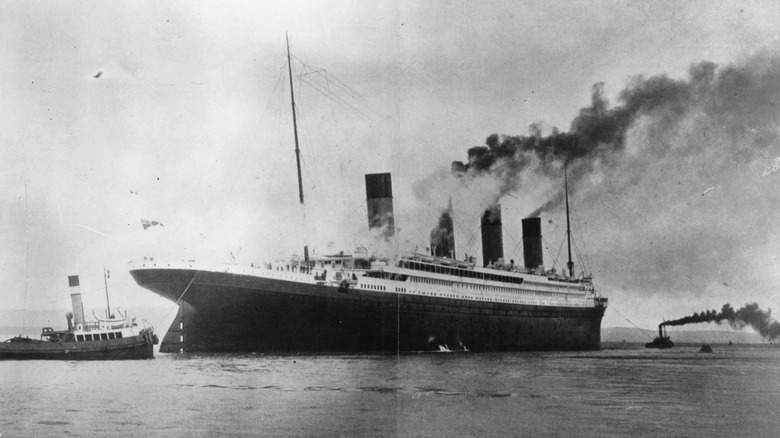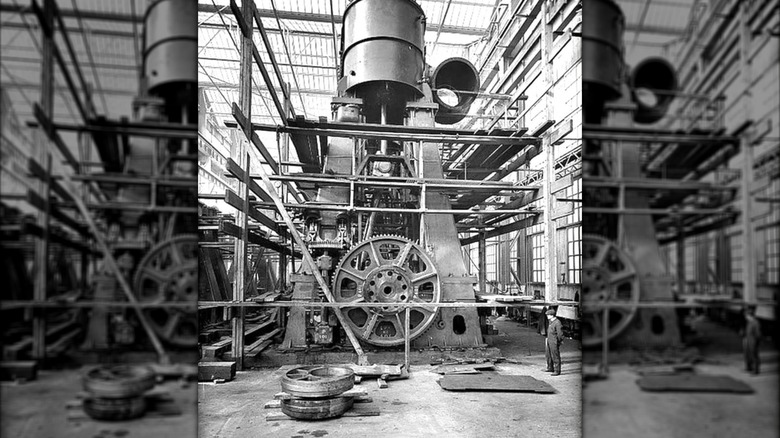How Fast Was The Titanic? A Look At Its Top Speed
The Royal Mail Ship (RMS) Titanic has become as much a pop culture icon as an epic historical tragedy. Aside from James Cameron's timeless film that made Leonardo DiCaprio and Kate Winslet global superstars, spoofs involving it have appeared in countless Hollywood projects like Ghostbusters II, Time Bandits, and The Simpsons, not to mention an anecdote (usually meant as a joke) to reference some kind of disaster.
When the colossal passenger liner set sail on its maiden journey on April 10, 1912, it was the largest such vessel of its kind afloat. It had an overall length of 882.75 feet, was 92.5 feet wide, and was 59.6 feet deep, with a gross tonnage of 46,329. Its seven decks were packed with a number of amenities never before seen on a ship, including a gymnasium, squash courts, a Turkish bath, a barber shop, and a swimming pool. In total, it cost an estimated $7.5 million to build.
To move the massive weight, the Titanic was powered by two triple-expansion reciprocating engines (each weighing over 1,000 tons and standing four stories tall) and one low-pressure turbine, all of which combined to provide 46,000 horsepower, which spun the two 3-bladed outboard wing propellers (each boasting a diameter of 23 and a half feet) and center propeller (with a diameter of 17 feet). Each day, 6,611 tons of coal were consumed to fuel these behemoth engines. She had a service speed of 21 knots (24 mph), but her estimated top speed was a few clicks more at 23 or 24 knots (approximately 26 – 27 mph), which is equivalent to the speed of today's modern cruise ships.
Powerful engines were needed push all that tonnage
According to the Royal Museums Greenwich, the Titanic had a maximum capacity of 3,295 people — 2,435 passengers (735 in first class, 674 in second class, and 1,026 in third class) and 885 crew. When she set sail from Southampton, England, on her way to New York, she only carried 2,208 people (1,317 passengers and 891 crew). Of those, 1,503 died (815 passengers and 688 crew). However, the report provided by the United States Senate regarding the tragedy claims 2,223 passengers and crew were aboard, with 1,517 dying.
At 11:40 PM on the evening of April 14, 1912, the Titanic's starboard hull (right side) hit an iceberg in the North Atlantic. At the time, the ship was going 20.5 knots (23.6 mph) despite receiving six warnings about the icy masses on the day leading to the tragedy. The collision opened five adjacent watertight compartments, enough to comprise the ship fatally. Theories suggest that she likely would have stayed afloat if only two compartments had been breached.
Unfortunately, she sank under the waves at 2:20 AM on April 15, two hours and forty minutes after striking the iceberg. The New York Times claimed that it took four hours for the ship to sink. The two broken pieces (the hull and the stern) are approximately 400 nautical miles southeast of Newfoundland, Canada, at a depth some 2.3 miles below sea level (or about 13,000 feet). It's so deep, in fact, that only 10 submarines are certified to reach the Titanic. The ship's debris is spread out over 15 square miles, and the hull is buried in 45 feet of mud.

